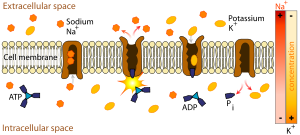
Primary active transport
Encyclopedia

Most of the enzymes that perform this type of active transport are transmembrane ATPases. A primary ATPase universal to all cellular life is the sodium-potassium pump, which helps to maintain the cell potential. Other sources of energy for Primary active transport are redox
Redox
Redox reactions describe all chemical reactions in which atoms have their oxidation state changed....
energy and photon
Photon
In physics, a photon is an elementary particle, the quantum of the electromagnetic interaction and the basic unit of light and all other forms of electromagnetic radiation. It is also the force carrier for the electromagnetic force...
energy (light
Light
Light or visible light is electromagnetic radiation that is visible to the human eye, and is responsible for the sense of sight. Visible light has wavelength in a range from about 380 nanometres to about 740 nm, with a frequency range of about 405 THz to 790 THz...
). An example of primary active transport using Redox energy is the mitochondrial electron transport chain
Electron transport chain
An electron transport chain couples electron transfer between an electron donor and an electron acceptor with the transfer of H+ ions across a membrane. The resulting electrochemical proton gradient is used to generate chemical energy in the form of adenosine triphosphate...
that uses the reduction energy of NADH to move protons across the inner mitochondrial membrane against their concentration gradient. An example of primary active transport using light energy are the proteins involved in photosynthesis
Photosynthesis
Photosynthesis is a chemical process that converts carbon dioxide into organic compounds, especially sugars, using the energy from sunlight. Photosynthesis occurs in plants, algae, and many species of bacteria, but not in archaea. Photosynthetic organisms are called photoautotrophs, since they can...
that use the energy of photons to create a proton gradient across the thylakoid membrane and also to create reduction power in the form of NADPH.
ATP utilizing Primary active transport types
(1) P-type ATPaseP-type ATPase
The P-type ATPases, also known as E1-E2 ATPases, are a large group of evolutionarily related ion pumps that are found in bacteria, archaea and eukaryotes. They are α-helical bundle primary transporters referred to as P-type ATPases because they catalyze auto- phosphorylation of a key conserved...
: Sodium potassium pump, Calcium pump
Calcium pump
There is a very large transmembrane electrochemical gradient of Ca2+ driving the entry of the ion into cells, yet it is very important for cells to maintain low concentrations of Ca2+ for proper cell signalling; thus it is necessary for the cell to employ ion pumps to remove the Ca2+.The PMCA and...
, Proton pump
Proton pump
A proton pump is an integral membrane protein that is capable of moving protons across a cell membrane, mitochondrion, or other organelle. Mechanisms are based on conformational changes of the protein structure or on the Q cycle.-Function:...
(2) F-ATPase
F-ATPase
F-ATPase, also known as F-Type ATPase , is an ATPase found in bacterial plasma membranes, in mitochondrial inner membranes, and in chloroplast thylakoid membranes...
: mitochondrial ATP synthase, Chloroplast ATP synthase
(3) V-ATPase
V-ATPase
Vacuolar-type H+-ATPase is a highly conserved evolutionarily ancient enzyme with remarkably diverse functions in eukaryotic organisms. V-ATPases acidify a wide array of intracellular organelles and pump protons across the plasma membranes of numerous cell types...
: vacuolar ATPase
(4) ABC (ATP Binding Cassette) transporter : MDR, CFTR, etc.

